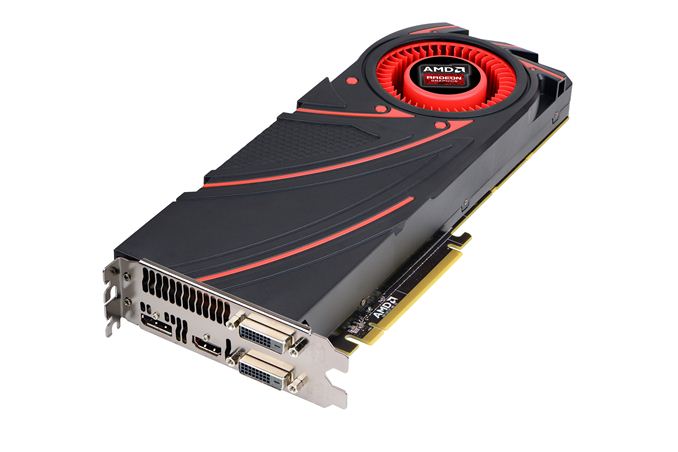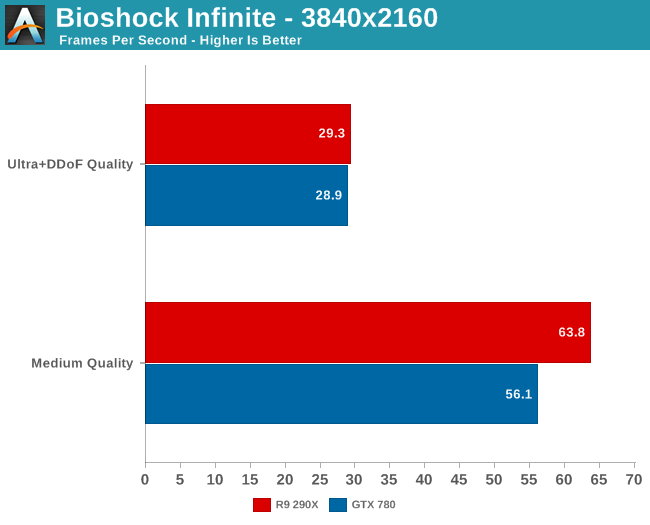AMD Radeon R9 290X Performance Preview: Bioshock Infinite
by Ryan Smith on October 17, 2013 3:00 PM EST- Posted in
- GPUs
- AMD
- Radeon
- Hawaii
- Radeon 200

As something of a counter-event to NVIDIA’s gaming showcase taking place in Montreal, Canada this week, AMD has organized an early, brief reveal of their forthcoming Radeon R9 290X video card. The card won’t be launching until sometime in the future, but for today we’re being allowed to confirm that we have the card and are being allowed to publish a single benchmark: Bioshock Infinite at 3840x2160 (4K).
AMD has purposely kept the public details on the R9 290X sparse so far, so we know little other than that it’s a larger GPU rated for 5 TFLOPS of compute performance, and paired with 4GB of memory for a total memory bandwidth of over 300GB/sec. Like most segments of the consumer electronics industry AMD has been gearing up for 3840x2160 (4K) displays, so the Radeon 290X is AMD’s flagship card geared towards gamers using 3840x2160 or 2560x1440 monitors.
Consequently AMD is seeking to draw attention to their 4K performance with today’s benchmark reveal. AMD named the game, the cards, and the resolution – Bioshock at 4K against the GTX 780 – so this is a very limited subset of our full results. And as with all controlled benchmark releases we’d advise not reading too much into any single benchmark here, as the relative performance of NVIDIA and AMD cards changes with the game being tested, at times rather wildly..

The biggest problem with 4K displays for at least the intermediate future, other than price of course, will be that you’re either going to need a lot of GPU power to drive them or will have to take a quality hit to achieve acceptable performance. Neither the R9 290X nor the GTX 780 are powerful enough to stay above 30fps on Bioshock with everything turned up. For that you will need to drop down to Medium quality, which gets performance past 30fps and up into the 60fps range. The fact that we’re even talking about playing a game at 60fps this high of a resolution – with 2.25 times as many pixels as 2560x1440 – is a big accomplishment right there, it’s just not one that will come without tradeoffs. For little-to-no compromise 4K gaming we’ll undoubtedly need to turn to multiple GPUs and Crossfire/SLI.
Moving on, it’s interesting to note in this case that both cards are essentially tied at Ultra quality, but when we dial down to medium the 290X takes a very decisive 14% lead. At the highest quality settings we should be shader/texture bound due to the significant use of shader effects on Bioshock’s highest quality settings, whereas at lower quality settings at least some of the bottleneck will shift to elements such as ROP throughput, memory bandwidth, and the geometry pipeline.
Wrapping this preview up, we’ll have more details on the 290X in the near future. AMD has made it clear that they are aiming high with their new flagship video card, so it will be interesting to see what they can pull off as we approach Tahiti/7970’s second birthday.













89 Comments
View All Comments
Principle - Friday, October 18, 2013 - link
OMG, get over it. They were allowed to present their data any way they wanted, no one told them what to write, only the scope. The full set of data will come out in a couple weeks at the latest. THEY ARE OPERATING ON A NON DISCLOSURE AGREEMENT. they have had results to report for weeks potentially, but were not allowed to release it. Does that make Anandtech evil, because they may have information they did not give to you??? But now that they gave you a little they are bad people?? The terms of an NDA are clear, the people that pay millions of dollars to bring that product to market get to decide when information is released. That NDA ends when the product is publicly released and all the data will flow. Why does this not make sense???????sorten - Thursday, October 17, 2013 - link
I'm not excited about the current generation of cards. It seems like NVidia and ATI both got caught napping when 4K monitors started to hit the scene and they've both been busy rebranding and overclocking existing hardware on the same manufacturing process. I'll wait and see what happens with the next generation.MrSpadge - Thursday, October 17, 2013 - link
What did you expect? A unicorn spraying fairy dust?The improvements over the 40 nm generation(s) are starting to become very significant. Can't ask for much more on the hardware front, unless the software changes as well.
sorten - Friday, October 18, 2013 - link
@MrSpadge : I wasn't expecting anything. I'm just saying that I'm keeping my money in my wallet. The advantages of 28nm over 40nm were very significant two years ago when that process change occurred. Since then there has been relatively little movement unless you're spending $600+ for a card, and even then you might be better off with two lower end cards.A5 - Thursday, October 17, 2013 - link
4K is still a tiny, tiny niche. They have SLI/XFire for the people who need to hit that resolution right now. By the time 4K is mainstreak (3-5 years?) they'll be able to handle it on one high-end card.ddriver - Thursday, October 17, 2013 - link
Hopefully the madness will end at 4k. Anything above is literal overkill, considering most people cannot distinguish between a 150 and 300 dpi image from normal viewing distance. A 4k monitor at 31.5" is about 150 ppi... There is really no point in rendering pixels that the human eye cannot distinguish.mcnabney - Thursday, October 17, 2013 - link
That is why I question need for some Ultra settings. When you can't really see the pixels the need for massive AA goes away. UHD resolutions need to be reviewed for appropriate detail levels.Nagorak - Thursday, October 17, 2013 - link
These ultra high res monitors just seem idiotic to me. When it comes to games you're just shooting yourself in the foot trying to run at such high resolution. It's going to look works being on medium settings than it would at high settings at a lower resolution.I bet most of the time people are going to end up running at half monitor res anyway if they want decent performance (basically equivalent to non-4K monitors).
jasonelmore - Thursday, October 17, 2013 - link
It wont. The higher resolution the resolution we can get, the closer we get to Holo Projection.Gigaplex - Thursday, October 17, 2013 - link
I can easily distinguish between 150 and 300 dpi at normal viewing distance... when it's static. It makes a massive difference for font rendering. I can't say I've experienced it in a game however so you may have a point for games.